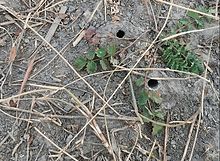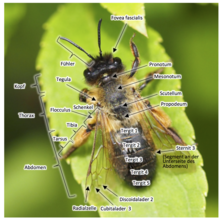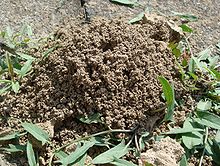Sand bees
| Sand bees | ||||||||||||
|---|---|---|---|---|---|---|---|---|---|---|---|---|

Common sand bee ( Andrena flavipes ) |
||||||||||||
| Systematics | ||||||||||||
|
||||||||||||
| Scientific name | ||||||||||||
| Andrena | ||||||||||||
| Fabricius , 1775 |
The sand bees ( Andrena ) form a very large genus within the bees (Apiformes). Worldwide more than 1,500 species belong to the genus Andrena . They are mainly found in the northern continents. In the Nearctic , south to Panama, a total of 522 species were described up to 2005, in the Palaearctic 949, and in Africa south of the Sahara 8 species. There are around 170 species of sand bees in Central Europe. 126 species are known from Germany.
Sand bees are solitary bees that collect pollen and build nests.
features
The sand bees are about 5 to 18 millimeters long. They have a black, black-red or rarely shiny metallic base color. They are furry to sparsely hairy and often wear light-colored hair ties on their abdomen. The sand bees are counted among the collecting bees because they collect the pollen with a hairbrush on their legs (rear rail). In addition, the females have a lock of hair on the underside of the thighs (so-called "flocculus") and mostly a "cup" on the sides of the middle segment. The females have a velvety, hairy, flat pit next to the eyes, the so-called fovea facialis, which is different depending on the species. Males often have brightly spotted faces. In the fore wing there are three cubital cells, of which the first is the largest, the middle one is the smallest. Only A. lagopus has only two cubital cells. As with almost all bees, the males have antennae with 13, the females with 12 limbs.
Many species can only be precisely determined by specialists, only a few can be clearly recognized by laypeople. The majority of the species occurring in Germany can only be determined in a prepared state with the aid of a binocular and often only with reference material.
habitat
Most species love dry and warm biotopes, they are typically open land species and live in grasslands, ruderal areas and fallow land. Many species occur in abandoned sand or gravel pits, or on richly structured forest edges. Many species are often found in gardens, parks, and on paths (e.g. A. bicolor, A. fulva, A. gravida, A. haemorrhoa , and A. nigroaenea ).
Nesting way
Sand bees nest endogeically, i.e. in the ground, and prefer more or less vegetation-poor places on clay, loess or sand-containing soils as a nesting place, which is why they are called sand bees or occasionally earth bees. As a rule, a female builds and cares for her nest on her own. There are species that look for completely vegetation-free places to nest (including A. argentata, A. barbilabris and A. vaga ). Andrena hattorfiana, on the other hand, prefers to nest under plant rosettes , while A. cineraria's nests are often found in park lawns.
Some species form so-called nest aggregations ( A. cineraria, A. vaga, A. nycthemera , A. fulva ), in which many nests of the same species are built close to one another. Some nest aggregations can contain several thousand nests. Of A. fulva nest aggregations described on park lawn and in the joints of paving.
While almost all sand bees live solitary (ie one female always cares for one or more nests alone), there are some communal species in which several females share a nest ( Andrena scotica , A. ferox and A. agilissima ).
Behaviors

Behavior of the males and copulations
The males often hatch a little earlier than the females and then actively search for females ready to mate in the nesting area. They sometimes patrol on fixed flight paths or around the nest entrances. Some of the routes the males fly are marked with scent marks. Mating mostly takes place on the ground or near the nesting sites on flowers. A. curvungula and A. pandellei often mate in the flowers of bluebells (the females mainly collect the pollen from bluebells). Mated females usually fend off further attempts at mating.
Nest building and pollen collecting
After mating, the females dig 5-60 cm deep tunnels in the ground, and old nests are occasionally used. The soil carried out is bound by the saliva in about 1–4 mm small clumps and is loosely piled up around the nest entrance. It often happens that when a bee approaches, particles of the earth roll back into the burrow and then have to be pushed out again. A rain shower comes in handy for the bees, because the saliva / soil mixture mixed by the moisture hardens when it dries and forms a safe and stable entrance to the burrow. The nests have side passages and always end in brood cells. Pollen and nectar are placed in the brood cells as a food base for the larvae and an egg is placed on each.
The larvae that hatch from the eggs consume the food supply and finally pupate after a few weeks. The adult bees then hatch in late summer, but remain in the brood cell until spring of the following year. The next generation will not hatch until the coming year.
Most native sand bees are polylectic, especially the common species (e.g. A. flavipes , A. fulva, A. gravida, A. haemorrhoa, A. helvola, A. labiata , A. minutula , A. nitida ). However, some species also specialize in individual plants or plant families. Andrena vaga and A. mitis, for example, only collect the pollen and nectar from willows , others only collect that from asparagus ( A. chrysopus ), bryos ( A. florea ), ox tongue ( A. nasuta ), but also from cruciferous vegetables ( A. lagopus ) umbellifers ( A. nitidiuscula ) or leguminous plants ( A. lathyri ). For some species, the flower visit is a valuable indicator for the identification of the species, for example A. lathyri can be found on Vicia and Lathyrus (both Fabaceae).
Phenology and seasonality
Many native species are active in spring (e.g. A. mitis, A. praecox ), most species fly in the months of April to June, but some even fly into late summer ( A. fuscipes ).
Most species have one generation per year, but some have two (including A. argentata, A. bicolor, A. dorsata, A. flavipes, A. minutula, A. morio, A. ovatula ).
Pseudocopulations
Especially in the Mediterranean area, the males of different species pollinate orchids of the genus Ophrys by so-called pseudo - population . The flowers of the orchids imitate female sand bees by their appearance and smell. A pollen packet is attached to the male thus attracted when attempting copulation. For example, A. nigroaenea pollinates the orchid Ophrys sphegodes, A. fuscosa pollinates O. mammosa . Pseudocopulations also occur in other bee species (e.g. Anthophora, Bombus, Eucera, Colletes, Megachile ).
Parasites
Wasp bees ( Nomada ) and blood bees ( Sphecodes ) lay their eggs as cuckoo bees in the nests of sand bees, so they are brood parasites . It is not observed that the sand bees show aggressive behavior towards the parasites. In addition, oil beetles (Meloidae), woolly swimmers (Bombyliidae) and fan-winged birds (Strepsiptera), especially of the Stylops melittae species, parasitize sand bees. Sand bees that are infested with stylops are sterile and change their behavior, phenology and morphology. They are called "stylopized".
species
Species occurring in Central Europe, selection of some species, predominantly widespread, not uncommon species (sub-genus after).
- Mustard blue shimmering sand bee Andrena (Agandrena) agilissima
- Andrena (Ptilandrena) angustior
- Andrena (Leucandrena) barbilabris
- Andrena (Euandrena) bicolor
- Andrena (Hoplandrena) carantonica (= A. scotica)
- Andrena (Notandrena) chrysosceles
- Gray sand bee ( Andrena (Melandrena) cineraria )
- Andrena (Andrena) clarkella
- Andrena (Lepidandrena) curvungula
- Andrena (Cnemidandrena) denticulata
- Andrena (Simandrena) dorsata
- Andrena (Micrandrena) falsifica
- Andrena (Hoplandrena) ferox
- Common sand bee ( Andrena (Zonandrena) flavipes )
- Andrena (Micrandrena) floricola
- Andrena (Andrena) fucata
- Red-furry sand bee ( Andrena (Andrena) fulva )
- Bryony sand bee ( Andrena (Poliandrena) florea )
- Andrena (Chrysandrena) fulvago
- Andrena (Cnemidandrena) fuscipes
- Andrena (Zonandrena) gravida
- Red-headed sand bee ( Andrena (Trachandrena) haemorrhoa )
- Knautien sand bee ( Andrena (Charitandrena) hattorfiana )
- Andrena (Andrena) helvola
- Andrena (Chlorandrena) humilis
- Andrena (Taeniandrena) intermedia
- Andrena (Holandrena) labialis
- Andrena (Poecilandrena) labiata
- Andrena (Biareolina) lagopus
- Andrena (Andrena) lapponica
- Andrena (Taeniandrena) lathyri
- Andrena (Micrandrena) minutula
- Andrena (Micrandrena) minutuloides
- Andrena (Andrena) mitis
- Andrena (Melandrena) nitida
- Andrena (Notandrena) nitidiuscula
- Andrena (Melandrena) nigroaenea
- Andrena (Andrena) nycthemera
- Andrena (Taeniandrena) ovatula
- Andrena (Lepidandrena) pandelle egg
- Andrena (Plastandrena) pilipes
- Andrena (Andrena) praecox
- Andrena (Proxiandrena) proxima
- Andrena (Lepidandrena) Arizona
- Andrena (Taeniandrena) similis
- Andrena (Micrandrena) strohmella
- Andrena (Micrandrena) subopaca
- Andrena (Plastandrena) tibialis
- Willow sand bee ( Andrena (Melandrena) vaga )
- Andrena (Andrena) varians
- Andrena (Larandrena) ventralis
- Andrena (Poecilandrena) viridescens
- Andrena (Taeniandrena) wilkella
Systematics
The genus Andrena belongs to the Andreninae subfamily within the Andrenidae family . Within the Andreninae there are the following genera (number of species in brackets): Ancylandrena (5, North America), Euherbstia (1, Chile), Megandrena (2, North America), Orphana (2, South America), Cubiandrena (2, Palaearctic / Palaeotropis ), Alocandrena (1, Peru) and Andrena with more than 1,500 species. The genus Andrena is the sister group of Alocandrena. These two are the sister group of ( Euherbstia + ( Orphana + ( Ancylandrena + Megandrena ))).
Due to the extraordinarily large number of species, the genus Andrena is divided into over 100 subgenus (17 holarctic , 51 palaearctic , 32 nearctic and one oriental ), but there are a number of species for which it is not clear which subgenus they belong to. The genus probably originated in the Mediterranean or Central Asia and is likely to have spread towards the end of the Cretaceous and early Tertiary.
There are also a number of taxonomic and nomenclature questions for native species that have not yet been clarified. For example, it is not clear whether A. confinis and A. congruens , or A. propinqua and A. dorsata are two separate species or one species, or whether the entire species complex A. curtula-pauxilla-pusilla-spreta still needs further investigation .
Sand bees and humans
Pollination : Like many wild bees, sand bees are often of great ecological importance for pollination, so they are of great benefit. According to Westrich, the sand bees are very effective pollinators of, for example, gooseberries, currants, strawberries, raspberries, blueberries and fruit trees.
Endangerment : According to the Red List, 10 of the 126 species in Germany are extinct or threatened with extinction (RL 0 or 1), 20 species are severely endangered (RL 2), another 20 are endangered (RL 3), only 36 species are not endangered.
Dangerousness : Sand bees are completely harmless to humans, their sting is so soft that it does not penetrate human skin. So you can watch the sand bees up close without any danger.
literature
- Ch. D. Michener: The Bees of the World. Johns Hopkins Univ. Press, Baltimore / London 2000, ISBN 0-8018-6133-0 .
- Andreas Müller, Albert Krebs, Felix Amiet: Bees: observation - way of life. Naturbuchverlag, Munich 1997, ISBN 3-89440-241-5 .
- Christian Schmid-Egger, Erwin Scheuchl: Illustrated identification tables for wild bees in Germany and Austria taking into account the species in Switzerland. Volume III: Andrenidae. Velden / Vils, self-published, 1997, ISBN 3-00-001407-1 .
- Paul Westrich: Germany's wild bees. E. Ulmer Verl., Stuttgart, 2018, ISBN 978-3-8186-0123-2
Web links
- Bee encyclopedia Sand bees: genus and species
- http://www.wildbienen.de/eb-andre.htm
- http://www.naturspaziergang.de/Portrait-Seiten/Bienen-Portrait.htm#Andreninae
Individual evidence
- ^ Friedrich Gusenleitner, Maximilian Schwarz: Checklist of the genus Andrena of the world. (PDF) In: Enomofauna Suppl. 12. 2002, accessed on March 11, 2017 .
- ^ Friedrich Gusenleitner, Maximilian Schwarz, John S. Ascher, Erwin Scheuchl: Corrections and Supplements to Gusenleitner & Schwarz (2002) "Worldwide checklist of the bee genus Andrena... " . In: Entomofauna . tape 26 , no. 26 . Ansfelden 2005, p. 347 - 472 ( zobodat.at [PDF]).
- ↑ a b c d E. Scheuchl & W. Willner: Pocket dictionary of the wild bees of Central Europe . Quelle & Meyer, 2016, ISBN 978-3-494-01653-5 , pp. 41-214 .
- ↑ a b E. Scheuchl, HR Schwenninger & M. Kuhlmann: Update of the checklist for wild bees in Germany, as of 10.09.2018 . Ed .: Commission for the taxonomy of wild bees of the working group wild bees cadastre. Stuttgart 2018, p. 26 ( wildbienen-kataster.de [PDF]).
- ↑ J. Schuberth & K. Schönitzer: Comparative morphology of the fovea facialis in Apoidea and Sphecidae (Hymenoptera, Aculeata) . In: Linzer biol. Contribution Volume 25 , no. 1 , 1993, p. 205–277 ( zobodat.at [PDF]).
- ↑ Julie Weissmann, H. Schaefer: Field determination aid for the wild bees of Bavaria (Hymenoptera; Apoidea) . In: NachrBl. bayer. Ent. tape 69 , no. 2 . Munich 2020, p. 1-64 .
- ^ Christian Schmid-Egger, Erwin Scheuchl: Illustrated tables of identification of wild bees in Germany and Austria . 3 Andrenidae. Velden 1997, p. 180 .
- ↑ a b c d e f g h i Paul Westrich: The wild bees of Germany . Eugen Ulmer, Stuttgart 2018, p. 105-112, 245-247, 444 .
- ^ H. Paulus: How insect males are deceived by orchid flowers - pollination tricks and evolution in the Mediterranean ragwort genus Ophrys . In: Denisia . NS 66. Linz 2007, p. 255–294 ( zobodat.at [PDF]).
- ↑ Ch. D. Michener: The Bees of the World . 2nd Edition. The Johns Hopkins Univ. Press, Baltimore 2007, pp. 68 f., 235-237 .
- ↑ a b c Andreas Dubitzky, John Plant, Klaus Schönitzer: Phylogeny of the bee genus Andrena Fabricius based on morphology (Hymenoptera: Andrenidae) . In: Communications of the Munich Entomological Society . tape 100 , 2010, p. 137–202 ( PDF on ZOBODAT ).
- ^ A b John D. Plant, Hannes F. Paulus: Evolution and Phylogeny of Bees . In: Zoologica . tape 161 . Schweizerbart Science Publishers, 2016, ISBN 978-3-510-55048-7 , pp. 187 ff .
- ^ P. Westrich: The wild bees of Germany . 2018, p. 107 .
- ^ P. Westrich: The wild bees of Germany . 2018, p. 88 .








